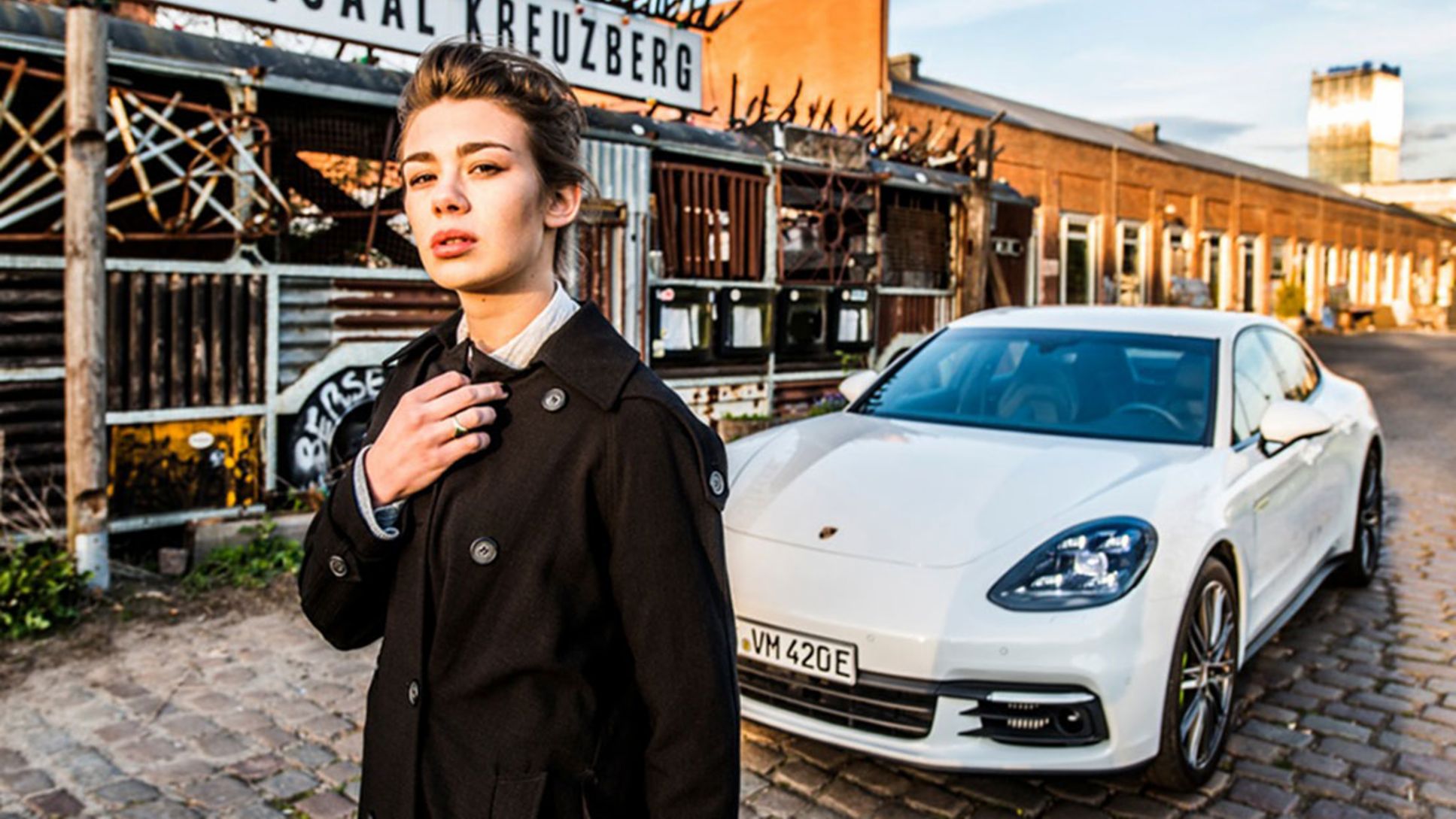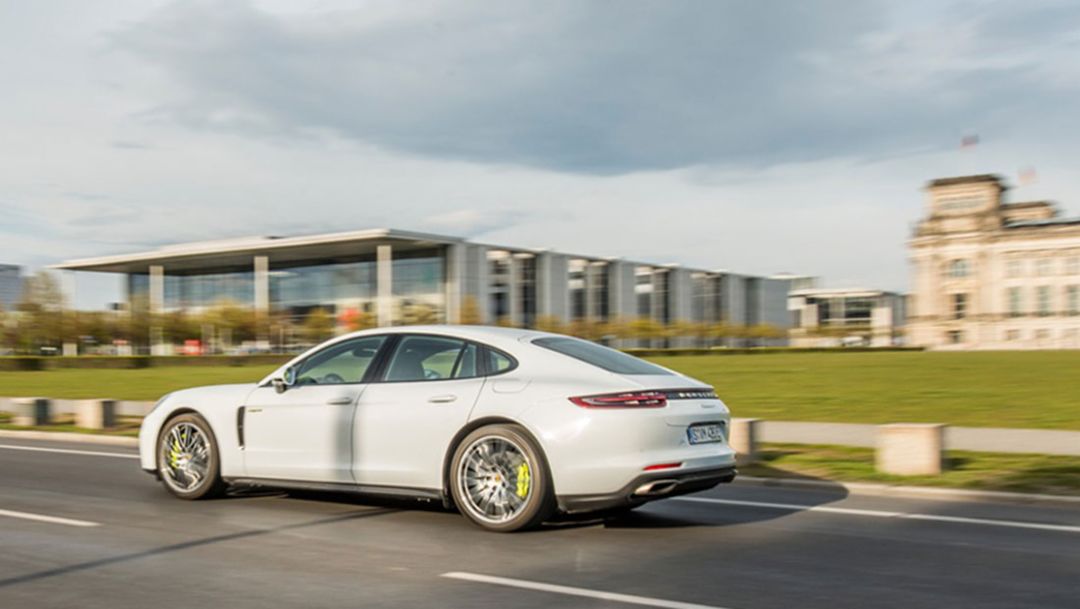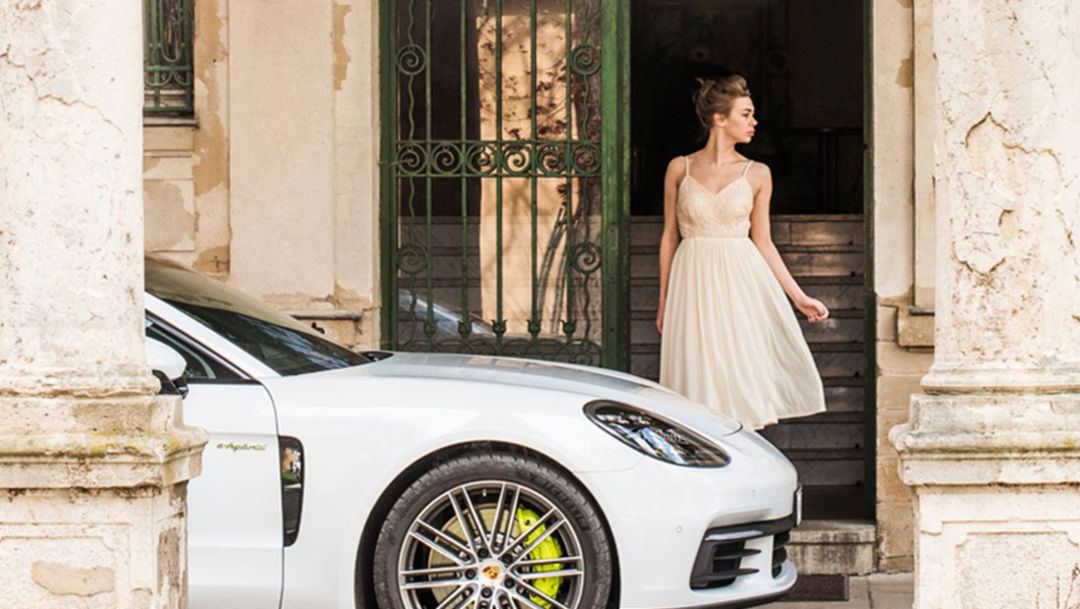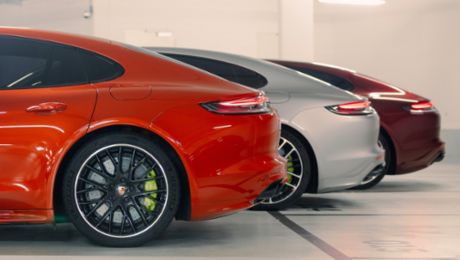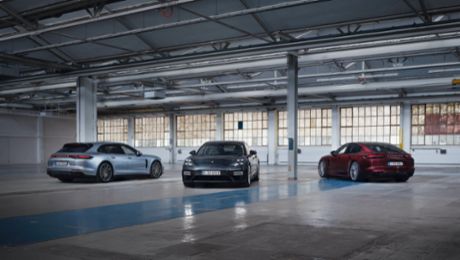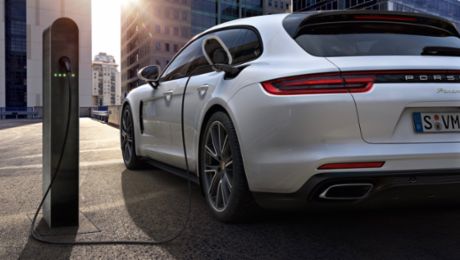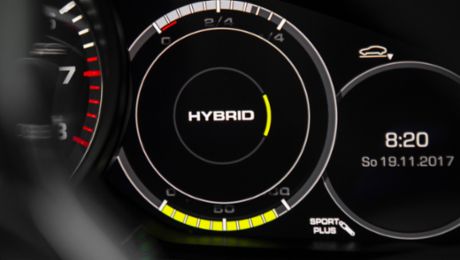People want to have it all. Freedom and commitment. A clear conscience and a long-haul trip. Free time and a successful career. Usually you can’t have your cake and eat it, but that’s just life. Some would say that an incessant desire for more is just greed. But I think it’s profoundly human. Mainly because I want it all, too. If I had my way, I’d run a huge and successful company from my bed while watching trashy TV and getting a degree at the same time. Unfortunately, our desires can’t usually be superimposed onto the chaotic reality of everyday life. So if dreams and reality can be brought closer and closer together, I think that’s progress.
It’s Monday morning. We’re standing in the car park of Porsche Centre Berlin-Potsdam, waiting for a car that was designed to fulfil (at least) two desires simultaneously. On the one hand is the classic driver’s craving for individual mobility and freedom. The second desire is a more recent one, since pure driving pleasure has been curbed somewhat by the throb of a guilty conscience. Nobody wants to put up with ridiculous emissions values in the long term just for the sake of their own enjoyment.
Earth is the only planet with Wi-Fi and pizza – that’s reason enough to treat it with a little more respect than we have over the past few decades. The Porsche Panamera 4 E-Hybrid is intended to combine both of these desires, as an electric motor meets horsepower. For a long time, hybrid vehicles were a compromise between sustainability and driving pleasure. They want to have it all – and this goal is steadily becoming closer to a reality. Having it all is also our goal over the next few days. We want Berlin, we want the countryside, we want to drive, we want to arrive.
The Panamera 4 E-Hybrid and Berlin: this is quite fitting
Berlin prides itself on being Berlin. It’s a little rough around the edges, but it’s a capital city; it’s poor, but it’s sexy; it’s urban, but it’s close to nature; it’s a city of cyclists, but it has a new airport. It’s probably the city with the most contrasts in Germany. But this is quite fitting, as the car we’re using is also full of contrasts. The Panamera 4 E-Hybrid offers everything you expect from a Porsche, and then some. Despite its size, it drives through the city with a quiet elegance. The electric motor transforms our city backdrop into a silent film.
Our first task is conquering the countryside. This another wonderful thing about driving a car: Within minutes, you can swap the city for secluded lakes without having to depend on a timetable, or anything else for that matter. This freedom is probably the last bastion of the automotive industry: I’m in complete control of when and where I drive.
Brandenburg is sprawling ahead of us. Spring has taken over the countryside – the Panamera 4 E-Hybrid seems to feel at home in the great outdoors and hugs the road. We pass streams, forests, fields and the Wannsee lake. Being on the road quickly starts to feel like home – maybe better than home, since unlike most men, the driver's seat can give massages for hours without complaining.
But being the greedy people we are, the countryside alone simply won’t suffice. We want lights, we want the city, we want speed. Half an hour later, our backdrop is completely changed. It’s the end of the working day: rush hour. The Panamera casually reaches the 50-kilometre range that is promised of the electric motor. This car isn’t one for roaring its engine at the traffic lights; instead, it silently and confidently makes its way through the rush hour traffic.
We set off early the next day. The on-board computer leads us effortlessly through the city centre – look, there’s Potsdamer Platz. Look, there’s Kreuzberg. Look, there’s the early morning. For me, the most important thing when it comes to cars is trust. The warm feeling that you only had when you were in your first car – when a car is your friend, literally a companion on your journey. Our Panamera keeps this promise: You have complete trust in it. I get the feeling that I’m driving assurance itself through the city in the form of a car. If you get bored of the silence, you can drive the car in sport mode – or like us, you can simply turn up the car radio as loud as it will go and sing along to terrible pop songs.
A visit to the Porsche Digital Lab
That evening, we caught a glimpse of the future. Many large companies are investing in “labs”, where new ideas are formed, discussed, rejected and implemented. Porsche is also testing and trying out innovative information technologies in its new Porsche Digital Lab, quickly turning a vague idea into a technical reality. While we were there we met Patrick Henkel, Chair of the Executive Board for Porsche Niederlassung Berlin GmbH and the Porsche Centres in Berlin. He accompanied us on our way to the new Porsche Centre Berlin-Adlershof. To make sure nobody misses the Centre, Porsche seem to have designed it with even a hapless, somewhat city-blind driver in mind: A solar-powered pylon is the jewel in the crown of the site: A gleaming monument to innovation, and a kind of visionary promise to customers. Adlershof is now the third pillar for Porsche in Berlin, with each of the Centres having their own specialism. “As a Porsche Classic Partner, Berlin-Potsdam is more orientated towards the past, while the Centre on Franklinstrasse in the city focuses on super sports cars”, explains Henkel. “Adlershof has two special work spaces where we can repair bodywork and use multi-material mixes”.
The next day, we escaped Berlin entirely. Just like any real city dweller, we were driven by our cravings for quiet and wide open spaces. And it felt much better to drive out into the country itself than to despairingly subscribe to a countryside magazine and start planting things on traffic islands. Our destination is Beesenstedt, a village in Saxony-Anhalt around two hours from the capital. The Autobahn is clear and we’re going faster than the somewhat pessimistic sat nav has predicted, but maybe that’s down to the fact that driving quickly in a Porsche is just so much fun. To reach the village, we have to cross the river Saale on a ferry, a journey that costs 1.20 euro. The country is a place for pragmatism, not major construction projects. Beesenstedt is a tranquil village with around 1,300 inhabitants. We see a small castle, an architectural reminder of long forgotten glamour. Out-of-tune pianos in the entrance hall, leather-bound encyclopaedias. We park the Panamera in front of the building and the mobile future meets the past. They are a great match, at least visually. At lunchtime, we stop for a bite to eat at “Jagdhütte Wettin” and see out our country outing by eating game goulash and dumplings.
But because the grass is always greener, it doesn’t take long after we’ve finished eating before our cravings return: To drive down the country roads one more time and have another taste of speed before we have to give the car back. We pass by bright yellow rapeseed fields, herds of sheep and secluded villages. I’m already looking forward to getting back to the city. Because this is the best thing about driving a car: You have no choice but to look ahead.
Ronja von Rönne
Our guest writer (born 1992) grew up in a village in Bavaria. It was pretty at first but ended up being boring, so she got her driver’s licence at 17 and escaped the village as quickly as possible. After a few semesters at university, Ronja von Rönne landed a job at the “Welt am Sonntag” newspaper in Berlin. She also writes a blog called “Sudelheft” that covers cars, popular culture and everything else. Her first novel, “Wir kommen” (We’re coming) was published in 2015 (Aufbau-Verlag), and a collection of her columns entitled “Heute ist leider schlecht” (It’s terrible today) was published earlier this year (S. Fischer Verlag).
Consumption data
Panamera 4 E-Hybrid: Fuel consumption combined 2.5 l/100 km; CO2 emissions 56 g/km; electricity consumption (combined) 15.9 kWh/100 km
